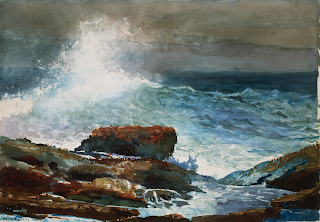 |
| It was so cold and I was displeased |
Initial Notes: I actually wrote a paper about this monument my freshman year here at University of Southern Maine. I believe it was for United States History since the 1900s with Professor Eagan and we had to chose a monument or outside event to write a short paper on. So, not to sound like an absolute hipster (even though I certainly do look like one) I did know about this monument since my first week or so attending this school. Whereas, yes, a lot of students who attend this university do not know what this monument is and don't really care to take the few minutes to walk over to it to find out.
Reaction: The Gorham Civil War Monument is made out of Italian marble and granite. It cost a whopping $3,060 to create. The column is twenty-four feet tall and is surrounded by a black iron fence with a small gate at the front. The monument was designed by William Johnson who was from Malden, Massachusetts (so from away). The monument has military emblems and a eagle perched upon the very top of it. There are fifty-seven names inscribed upon the sides of monuments. What is interesting about this monument is not only are the men's names on the monument, but their birth date/death date, where they served, and where they died. This monument holds so much historical significance and information all in one place. No monuments I can think of have this much or detailed information about the people it is in memorial of.
Courtesy of Professor Libby Bischof, I have a lot of information on this monument that is helping me write this entry. I wish I had this information when I had to write my paper three or so years ago. The monument was erected and created because of the generosity of Toppan Robie who was a influential citizen of Gorham, Maine. Robie offered to erect the monument in October of 1865 and it was on October 18, 1866 that it was officially dedicated to the men who had perished during the Civil War. On the day it was dedicated hundreds of people showed up. Townspeople, families of the soldiers, veterans, and notable dignitaries were among the people who arrived to see the monument be dedicated. The amount of people in attendance shows how important this was to the town and to the people it was made for. Joshua Lawrence Chamberlain was also there and gave the primary oration "Dead on the Field of Honor".
Robie wanted to create the monument to honor all the men who perished on the battlefield or even afterwards from their wounds. He wanted it placed in front of the Town House, which leads to a fact I did not originally know. The art house on the Gorham campus used to the Gorham's town hall. So, back when it was originally erected everyone in Gorham saw the monument on a daily basis. It could not be ignored, so the sacrifices of the men who served were not forgotten because people could always see it and acknowledge it.
Now, however, that building is not the town house. It is an art exhibit on a college campus where most students don't take the time to find out what this monument is. This project has been both enlightening and somewhat depressing. There are so many historical things around this great state that have been forgotten. So many influential and important people that aren't recognized anymore, landmarks that are overgrown and destroyed. I may only be a History minor, but this project has made me want to see these historical sites revived and restored, acknowledged again!
























